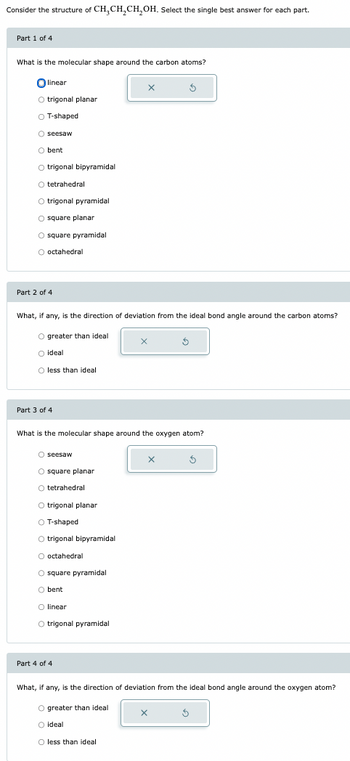
Chemistry: Principles and Reactions
8th Edition
ISBN: 9781305079373
Author: William L. Masterton, Cecile N. Hurley
Publisher: Cengage Learning
expand_more
expand_more
format_list_bulleted
Question
Show work with explanation needed. Don't give Ai generated solution

Transcribed Image Text:Consider the structure of CH3CH2CH2OH. Select the single best answer for each part.
Part 1 of 4
What is the molecular shape around the carbon atoms?
linear
trigonal planar
O T-shaped
seesaw
O bent
O trigonal bipyramidal
O tetrahedral
O trigonal pyramidal
O square planar
square pyramidal
O octahedral
Part 2 of 4
What, if any, is the direction of deviation from the ideal bond angle around the carbon atoms?
O greater than ideal
O ideal
O less than ideal
Part 3 of 4
What is the molecular shape around the oxygen atom?
O seesaw
square planar
tetrahedral
O trigonal planar
○ T-shaped
O trigonal bipyramidal
O octahedral
O square pyramidal
bent
O linear
O trigonal pyramidal
Part 4 of 4
What, if any, is the direction of deviation from the ideal bond angle around the oxygen atom?
O greater than ideal
O ideal
O less than ideal
Expert Solution
This question has been solved!
Explore an expertly crafted, step-by-step solution for a thorough understanding of key concepts.
Step by stepSolved in 2 steps with 1 images

Knowledge Booster
Similar questions
- It is possible to write a simple Lewis structure for the SO42- ion, involving only single bonds, which follows the octet rule. However, Linus Pauling and others have suggested an alternative structure, involving double bonds, in which the sulfur atom is surrounded by six electron pairs. (a) Draw the two Lewis structures. (b) What geometries are predicted for the two structures? (c) What is the hybridization of sulfur in each case? (d) What are the formal charges of the atoms in the two structures?arrow_forwardAmong the following, which has the shortest bond and which has the longest: Li2, B2, C2, N2, O2?arrow_forwardUse Lewis structures and VSEPR theory to predict the electron-region and molecular geometries of (a) PSCl3. (b) SOF6. (c) [S2O4]2. (d) [TeF4]2. Note any differences between these geometries.arrow_forward
- In addition to CO, CO2, and C3O2, there is another molecular oxide of carbon, pentacarbon dioxide, C5O2, a yellow solid. (a) What is the approximate C-to-C-to-O bond angle in pentacarbon dioxide? (b) What is the approximate C-to-C-to-C bond angle in this compound?arrow_forwardIndicate which molecules are polar and which are nonpolar. (a) SeO2 (b) N2O (N is the central atom) (c) SCl4arrow_forwardExplain why CF4 and Xef4 are nonpolar compounds (have no net dipole moments) while SF4 is polar (has a net dipo le moment). Is CO2 polar? What about COS?arrow_forward
- Following are the structures of three isomers of difluorobenzene, C6H4F2. Are any of them nonpolar?arrow_forwardTwo variations of the octahedral geometry (see Table 4-1) are illustrated below. Which of the compounds/ions Br3, ClF3, XeF4, SF4, PF5, ClF5, and SF6 have these molecular structures?arrow_forward4. What is the molecular geometry of N2O (where the atoms are connected in the order NNO)? linear, 180° angle bent, 109.5° angle bent, 90° angle bent, 120° anglearrow_forward
- A variety of chlorine oxide fluorides and related cations and anions are known. They tend to be powerful oxidizing and fluorinating agents. FClO3 is the most stable of this group of compounds and has been studied as an oxidizing component in rocket propellants. Draw a Lewis structure for F3ClO, F2ClO2+, and F3ClO2. What is the molecular structure for each species, and what is the expected hybridization of the central chlorine atom in each compound or ion?arrow_forwardGive all the ideal bond angles (109.5, 120, or 180) in the following molecules and ions. (The skeleton does not imply geometry.) (a) Cl—S—Cl(b) F—Xe—F(c) (d)arrow_forwardPredict the molecular structure and bond angles for each molecule or ion in Exercises 87 and 93. a. CCl4 b. NCl3 c. SeCl2 d. ICl a. NO2, NO3, N2O4 (N2O4 exists as O2NNO2.) b. OCN, SCN, N3 (Carbon is the central atom in OCN and SCN.)arrow_forward
arrow_back_ios
SEE MORE QUESTIONS
arrow_forward_ios
Recommended textbooks for you
 Chemistry: Principles and ReactionsChemistryISBN:9781305079373Author:William L. Masterton, Cecile N. HurleyPublisher:Cengage Learning
Chemistry: Principles and ReactionsChemistryISBN:9781305079373Author:William L. Masterton, Cecile N. HurleyPublisher:Cengage Learning Chemistry: The Molecular ScienceChemistryISBN:9781285199047Author:John W. Moore, Conrad L. StanitskiPublisher:Cengage Learning
Chemistry: The Molecular ScienceChemistryISBN:9781285199047Author:John W. Moore, Conrad L. StanitskiPublisher:Cengage Learning Chemistry & Chemical ReactivityChemistryISBN:9781337399074Author:John C. Kotz, Paul M. Treichel, John Townsend, David TreichelPublisher:Cengage Learning
Chemistry & Chemical ReactivityChemistryISBN:9781337399074Author:John C. Kotz, Paul M. Treichel, John Townsend, David TreichelPublisher:Cengage Learning Chemistry & Chemical ReactivityChemistryISBN:9781133949640Author:John C. Kotz, Paul M. Treichel, John Townsend, David TreichelPublisher:Cengage Learning
Chemistry & Chemical ReactivityChemistryISBN:9781133949640Author:John C. Kotz, Paul M. Treichel, John Townsend, David TreichelPublisher:Cengage Learning General Chemistry - Standalone book (MindTap Cour...ChemistryISBN:9781305580343Author:Steven D. Gammon, Ebbing, Darrell Ebbing, Steven D., Darrell; Gammon, Darrell Ebbing; Steven D. Gammon, Darrell D.; Gammon, Ebbing; Steven D. Gammon; DarrellPublisher:Cengage Learning
General Chemistry - Standalone book (MindTap Cour...ChemistryISBN:9781305580343Author:Steven D. Gammon, Ebbing, Darrell Ebbing, Steven D., Darrell; Gammon, Darrell Ebbing; Steven D. Gammon, Darrell D.; Gammon, Ebbing; Steven D. Gammon; DarrellPublisher:Cengage Learning

Chemistry: Principles and Reactions
Chemistry
ISBN:9781305079373
Author:William L. Masterton, Cecile N. Hurley
Publisher:Cengage Learning

Chemistry: The Molecular Science
Chemistry
ISBN:9781285199047
Author:John W. Moore, Conrad L. Stanitski
Publisher:Cengage Learning

Chemistry & Chemical Reactivity
Chemistry
ISBN:9781337399074
Author:John C. Kotz, Paul M. Treichel, John Townsend, David Treichel
Publisher:Cengage Learning

Chemistry & Chemical Reactivity
Chemistry
ISBN:9781133949640
Author:John C. Kotz, Paul M. Treichel, John Townsend, David Treichel
Publisher:Cengage Learning

General Chemistry - Standalone book (MindTap Cour...
Chemistry
ISBN:9781305580343
Author:Steven D. Gammon, Ebbing, Darrell Ebbing, Steven D., Darrell; Gammon, Darrell Ebbing; Steven D. Gammon, Darrell D.; Gammon, Ebbing; Steven D. Gammon; Darrell
Publisher:Cengage Learning
